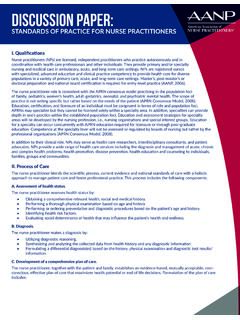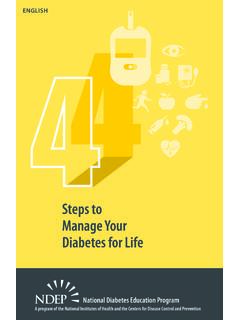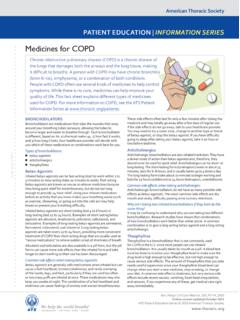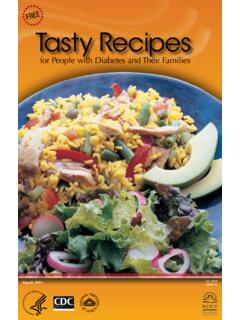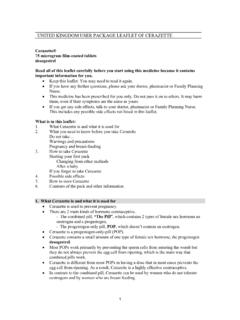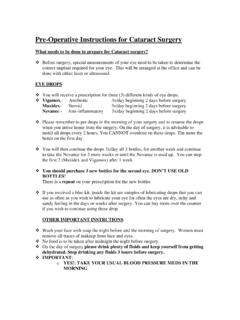Transcription of Living with Type 2 Diabetes - American Association of ...
1 Supported by Boehringer Ingelheim Pharmaceuticals, Inc. and Eli LillyLiving with Type 2 DiabetesDI650105 PARWhat is Diabetes ? Diabetes affects the way your body uses food Most foods are broken down into glucose, a form of sugarin the blood Insulin is needed to move glucose to all the cells in your body The pancreas makes and releases insulin when you eat After eating, glucose travels through the bloodstream,where cells use it for growth and energy Diabetes is caused when the pancreas does not make enoughinsulin or does not use it in the right way.
2 When this happens: Glucose builds up in the blood and overflows intothe urine High levels of glucose can damage different partsof the bodyTreatment Goals Enjoy an active, healthy lifestyle Control your blood glucose levels Control symptoms Lower your risk of heart disease and stroke Lower your risk of eye, nerve, foot, and kidney problems Lower your risk of other health problems If you smoke, stopGoals for Glucose LevelsTarget Glucose Levels Less than 180 mg/dL 1 to 2 hours after start of a meal 90 to 130 mg/dL after not eating for 8 or more hours 80 to 130 mg/dL before eating A1c <7% for most people Your healthcare provider will work with you to set a goal for your glucose levels Checking and Tracking blood Glucose Levels Self-monitoring blood glucose (SMBG)
3 Is part of yourtreatment plan SMBG tells you your glucose level at a selected pointin time Follow directions given by the maker of your home glucosemonitor to get reading Your healthcare provider decides how often and when youshould do SMBGM edicines for Type 2 Diabetes Successful treatment for type 2 Diabetes includes bothlifestyle changes and medicines There are several kinds of medicines to control glucoselevels, including: Pills Insulin Medicines given by a shot or breathed in (inhaled) You may take one medicine or a combination of medicines Because Diabetes progresses over time, your medicinesmay changeHealthy Eating Most foods affect your glucose levels Talk with your healthcare provider before making any changesto your eating habits Your healthcare provider may ask you to eat different kinds ofhealthy foods that you enjoy such as.
4 High-fiber foods (cereal, vegetables, beans, and grains) Low-fat dairy foods (skim milk) Low-fat meats (chicken, pork, or fish) High-protein foods (chicken, eggs, beans) Your healthcare provider may ask you to limit the amountyou eat of: High-fat foods such as chips, full-fat cheese, whole milk,and butter Sugar-sweetened drinks such as soda and juices High-salt foods (canned soups, processed meats),especially if you have high blood pressure Keeping a daily record of the food and amounts you eatmay be helpful Your healthcare provider may refer you to a dietitian ornutritionist to help you learn about healthy eatingNOTESP hysical Activity Talk with your healthcare provider before making any changesto your exercise habits.
5 Your healthcare provider may offer thefollowing advice: Make physical activity part of your daily life Work up to at least 30 minutes per day for 5 or moredays per week This can be broken down into three 10-minute sessionsduring the day Choose activities that you enjoy Working out with a buddy can help you stick with it You may need to check your glucose levels before andafter physical activity Ask your healthcare provider to help you develop anactivity plan that works for youFoot CareFollow these steps to lower your chances of foot problems Wash your feet each day with mild
6 Soap and water and drywell, especially between your toes Use lotion to prevent dryness and cracking, avoid puttingbetween toes Check your feet every day for dry, cracked skin, blisters,sores, cuts, scratches, redness or soreness, callouses, andingrown toenails Always wear properly fitted shoes with cotton, wool, orcotton-wool blend socks; never go barefoot even in the house Take care of your toenails Cut toenails straight across with nail clippers, afterbathing, when they are soft Smooth rough edges Never use scissors, razors.
7 Or other sharp toolsManaging Type 2 Diabetes When You Are Sick Being sick can increase glucose levels and you need to takespecial care of yourself Check your glucose levels more often Call your healthcare provider if glucose levels are toohigh or too low Keep taking all of your medicines as prescribed by yourhealthcare provider Try to drink at least to cup of water, diet soda, or teawithout sugar every 30 to 60 minutes Try to eat your usual foods If you can t eat, drink enough liquids or eat soft foods totake the place of foods you usually eat Check your temperature, because a fever can be a sign ofinfection Call your healthcare provider if your fever is above 100 F Ask your healthcare provider how often you should checkwith them when you are sickWhat is Low blood Glucose?
8 (Hypoglycemia) Hypoglycemia is caused by very low glucose levels, usuallyless than 70 mg/dLCausesSignsEating less than usualSweating or the chillsMissing a mealFeeling irritable, angry, stubborn, or sad without reasonEating later than usualFeeling confusedBeing more active than usualDizzy or lightheadedTaking too much Diabetes medicineFast heartbeatDrinking beer, wine, or liquorBlurry vision, feeling tired,losing consciousnessTreatment for Low blood Glucose (Hypoglycemia)The 15:15 Rule to Treat Hypoglycemia Recheck your glucose levels 15 minutes after you eat15 grams of glucose If glucose levels are still low, eat 15 more grams of glucose every 15 minutes until your glucose level is above 80 mg/dL Always carry some kind of food or drink with you to treat low glucose Check glucose levels before doing important tasks such as driving To prevent low glucose levels.
9 Don t skip meals Examples of 15 Grams of Glucose 3 to 4 glucose tablets2 tablespoons of raisinsHalf a cup of juice or non-diet soda3 to 5 pieces of hard candyLiving with Type 2 DiabetesSupported by Boehringer Ingelheim Pharmaceuticals, Inc. and Eli LillyDI650105 PAR



